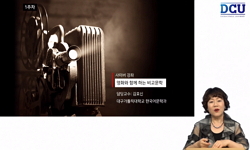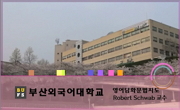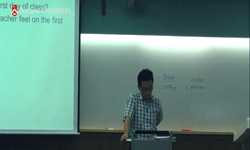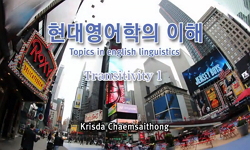Since 1990’s, we have been living in a time when literature has lost its position as total culture and is considered as sub-culture, which is surrounding culture. This research has significance for the fact that it tries to approach ‘Genzaburo Oe...
http://chineseinput.net/에서 pinyin(병음)방식으로 중국어를 변환할 수 있습니다.
변환된 중국어를 복사하여 사용하시면 됩니다.
- 中文 을 입력하시려면 zhongwen을 입력하시고 space를누르시면됩니다.
- 北京 을 입력하시려면 beijing을 입력하시고 space를 누르시면 됩니다.
https://www.riss.kr/link?id=A100504592
-
저자
조헌구 (경북대학교)
- 발행기관
- 학술지명
- 권호사항
-
발행연도
2015
-
작성언어
Korean
-
주제어
이야기하기 ; 비교문학 ; 오에 겐자부로 ; 무라카미 하루키 ; Discourse ; Comparative literature ; Genzaburo Oe ; Haruki Murakami
-
등재정보
KCI등재
-
자료형태
학술저널
- 발행기관 URL
-
수록면
351-370(20쪽)
-
KCI 피인용횟수
0
- DOI식별코드
- 제공처
-
0
상세조회 -
0
다운로드
부가정보
다국어 초록 (Multilingual Abstract)
As a step towards it, this paper brought 『Letter to faint nostalgia』 and 『Norwegian Wood』 as main comparison subject texts. Each text has something in common in that it has similar way of building a story, but has difference in the story of ‘I’, namely Oe and Haruki tried some changes on the narrator’s ‘discourse’.
Based on above common ground, this paper compared and analysed between the story of ‘I = A NOVELIST K’ and ‘I = WATANABE’ in the ‘discourse’ level putting distance from the Expression of Autobiographical Memory. As a result of that, this paper could draw out the analysis possibility of ‘I’, who leads readers to meta-fiction.
Since 1990’s, we have been living in a time when literature has lost its position as total culture and is considered as sub-culture, which is surrounding culture. This research has significance for the fact that it tries to approach ‘Genzaburo Oe’ and ‘Haruki Murakami’ by reverting these people to cultural text, not to culture, in the context of master narrative, constructed in the absence of total culture. Namely, by accommodating these people as cultural text, this paper progressed discussion on ‘Oe’ and ‘Haruki’ keeping existing social ‘discourse’ on them, formed in Korean society, away.
As a step towards it, this paper brought 『Letter to faint nostalgia』 and 『Norwegian Wood』 as main comparison subject texts. Each text has something in common in that it has similar way of building a story, but has difference in the story of ‘I’, namely Oe and Haruki tried some changes on the narrator’s ‘discourse’.
Based on above common ground, this paper compared and analysed between the story of ‘I = A NOVELIST K’ and ‘I = WATANABE’ in the ‘discourse’ level putting distance from the Expression of Autobiographical Memory. As a result of that, this paper could draw out the analysis possibility of ‘I’, who leads readers to meta-fiction.
목차 (Table of Contents)
- Abstract
- 1. 들어가며
- 2. 오에와 하루키의 ‘변화’를 통한 이항대립구조의 해체
- 3. ‘나’의 ‘이야기하기’의 변주-텍스트에서 ‘하루키’를 지우다
- 4. ‘나’의 ‘이야기하기’의 변주-컨텍스트로서의 ‘오에’를 구축하다
- Abstract
- 1. 들어가며
- 2. 오에와 하루키의 ‘변화’를 통한 이항대립구조의 해체
- 3. ‘나’의 ‘이야기하기’의 변주-텍스트에서 ‘하루키’를 지우다
- 4. ‘나’의 ‘이야기하기’의 변주-컨텍스트로서의 ‘오에’를 구축하다
- 5. 나오며
- 참고문헌
- REFERENCES
참고문헌 (Reference)
1 이한섭, "한국일본문학관계연구문헌일람1945-1997" 고려대학교출판부 1-454, 2000
2 자료조사연구실, "하루키문학수첩" 문학사상사 33-165, 1996
3 최성실, "일본문학의 한국적 수용과 특징―무라카미와 문화번역" 경원대학교아시아 문화연구소 13 : 71-89, 2007
4 윤상인, "일본문학의 한국어 번역 현황에 관한 조사(1945-1997)" 한양대학교 일본학회 6 : 167-171, 1998
5 안영희, "일본 사소설과『외딴방』" 동아시아일본학회 (33) : 359-383, 2010
6 이성욱, "심약한 지식인에 어울리는 파멸, 이인화의「내가 누구인지 말할 수 있는 자는 누구인가」표절 시비에 대해" 한길사 13 : 270-298, 1992
7 박진, "서사학과 텍스트 이론" 소명출판 11-29, 2014
8 한기호, "베스트셀러30년" 교보문고 118-204, 2011
9 박진, "그래서 우리는 소설을 읽는다" 자음과모음 13-29, 2011
10 양정아, "韓國における日本文學の受容―村上春樹『ノルウェイの森』を中心に" 3 : 415-430, 2007
1 이한섭, "한국일본문학관계연구문헌일람1945-1997" 고려대학교출판부 1-454, 2000
2 자료조사연구실, "하루키문학수첩" 문학사상사 33-165, 1996
3 최성실, "일본문학의 한국적 수용과 특징―무라카미와 문화번역" 경원대학교아시아 문화연구소 13 : 71-89, 2007
4 윤상인, "일본문학의 한국어 번역 현황에 관한 조사(1945-1997)" 한양대학교 일본학회 6 : 167-171, 1998
5 안영희, "일본 사소설과『외딴방』" 동아시아일본학회 (33) : 359-383, 2010
6 이성욱, "심약한 지식인에 어울리는 파멸, 이인화의「내가 누구인지 말할 수 있는 자는 누구인가」표절 시비에 대해" 한길사 13 : 270-298, 1992
7 박진, "서사학과 텍스트 이론" 소명출판 11-29, 2014
8 한기호, "베스트셀러30년" 교보문고 118-204, 2011
9 박진, "그래서 우리는 소설을 읽는다" 자음과모음 13-29, 2011
10 양정아, "韓國における日本文學の受容―村上春樹『ノルウェイの森』を中心に" 3 : 415-430, 2007
11 桜井哲夫, "閉ざされた殻から姿をあらわして―『ノルウェイの森』とベストセラーの構造" 青土社 21 (21): 182-187, 1989
12 岩倉具忠, "言語と自由意志―ダンテの言語思想についての一考察" イタリア学会 (47) : 1-17, 1997
13 村上春樹, "著者からのメッセージ"
14 小林秀雄, "経済往来" 経済往来社 364-369, 1935
15 小島明子, "王国維の文学普遍論―ゲーテ「世界文学」との比較から" お茶の水女子大学大学院人間文化創成科学研究科 12 : 73-81, 2009
16 Gérard Genette, "物語のディスクール―方法論の試み" 書肆風の薔薇 27-69, 1985
17 小森陽一, "物語という回路" 新曜社 209-252, 1992
18 山本芳明, "正宗白鳥と〈私小説〉言説の生成―〈出来事〉としての「人生の幸福」" 学習院大学 52 : 51-74, 2005
19 村上春樹, "村上春樹全作品 1979∼1989" 講談社 1991
20 宇佐美毅, "村上春樹と一九八〇年代" おうふう 281-296, 2008
21 松本和也, "村上春樹『ノルウェイの森』への一視覚―80年代末の女性雑誌と〈恋愛小説〉" 立教大学 84 : 127-138, 2000
22 加藤典洋, "文学地図" 朝日新聞出版 207-252, 2008
23 村上春樹, "山羊さん郵便みたいに迷路化した世界の中で―小説の可能性" 青土社 21 (21): 8-38, 1989
24 大江健三郎, "大江健三郎小説" 新潮社 1997
25 大江健三郎, "パンフレット" 新潮社 1-, 1996
26 越川芳明, "『ノルウェイの森』―アメリカン・ロマンスの可能性" 青土社 21 (21): 188-198, 1989
동일학술지(권/호) 다른 논문
-
J-GAPを通して高等学校と大学と社会のアーティキュレーションを考える
- 대한일어일문학회
- 鄭起永
- 2015
- KCI등재
-
- 대한일어일문학회
- 조치영
- 2015
- KCI등재
-
- 대한일어일문학회
- 金小英
- 2015
- KCI등재
-
- 대한일어일문학회
- 윤혜민
- 2015
- KCI등재
분석정보
인용정보 인용지수 설명보기
학술지 이력
| 연월일 | 이력구분 | 이력상세 | 등재구분 |
|---|---|---|---|
| 2026 | 평가예정 | 재인증평가 신청대상 (재인증) | |
| 2020-01-01 | 평가 | 등재학술지 유지 (재인증) |  |
| 2017-01-01 | 평가 | 등재학술지 선정 (계속평가) |  |
| 2016-01-01 | 평가 | 등재후보학술지 유지 (계속평가) |  |
| 2015-12-01 | 평가 | 등재후보로 하락 (기타) |  |
| 2011-01-01 | 평가 | 등재학술지 유지 (등재유지) |  |
| 2009-01-01 | 평가 | 등재학술지 유지 (등재유지) |  |
| 2006-01-01 | 평가 | 등재학술지 선정 (등재후보2차) |  |
| 2005-01-01 | 평가 | 등재후보 1차 PASS (등재후보1차) |  |
| 2003-01-01 | 평가 | 등재후보학술지 선정 (신규평가) |  |
학술지 인용정보
| 기준연도 | WOS-KCI 통합IF(2년) | KCIF(2년) | KCIF(3년) |
|---|---|---|---|
| 2016 | 0.35 | 0.35 | 0.29 |
| KCIF(4년) | KCIF(5년) | 중심성지수(3년) | 즉시성지수 |
| 0.27 | 0.24 | 0.556 | 0.05 |




 KCI
KCI DBpia
DBpia






